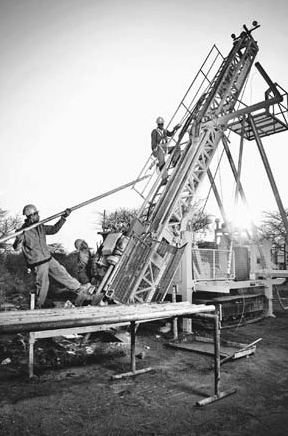While Namibia has become more known for uranium and diamonds in the mining world over the years, Auryx Gold (AYX-T) is looking to prove the country can hold its own in the gold department as well.
And while Auryx only listed on the TSX in July 2010, its belief in the gold prospectiveness of the country has been met with market enthusiasm.
The company began trading in the secondary market at 50¢ a share, but by mid-August its share price began to move, closing at a high of $1.35 on Oct. 26.
Such bullishness on its stock can be attributed to the potential of its Otjikoto gold project, located 300 km north of the capital city Windhoek, which boasts almost 2 million oz. gold. Those ounces come out of 28.4 million tonnes of indicated resources grading 1.34 grams gold for 1.2 million oz. gold and another 17.7 million tonnes grading 1.28 grams gold for 708,000 oz.
Speaking at MineAfrica’s Africa Investor Series in Toronto on Oct. 29, Auryx president Tim Searcy explained that the news is likely to get better as a resource update due out early next year will aim to reduce the tonnage in the estimate, thus increasing the average grades while maintaining the overall ounces.
That such a transformation of quality is even possible is thanks to the manner in which the original resource was outlined.
Otjikoto was discovered by Teal Exploration and Mining, a former base metal junior explorer that was looking for copper deposits underneath the Namibian sands.
When it realized it had a significant gold zone on its hands, Teal didn’t shy away as it spent $26 million on more than 76,000 metres of drilling.
And while the company was able to prove up a substantial resource out of such drilling, because it was accustomed to outlining base metal deposits, it was in a bulk-tonnage mindset and applied such a methodology to the resource estimate for Otjikoto.
The nature of the mineralization, according to Searcy however, allows for a more focused mining approach than bulk tonnage implies, meaning that the strip ratio could be dramatically reduced.
Also bolstering Searcy’s optimism for the project is the fact that so little drilling has been done on the southern extension of the zone. To date, only 7 holes have been drilled in the area, and while only one returned gold mineralization, he points out that the first 10 holes put into the initial discovery that currently comprises the resource estimate returned very limited intercepts as well.
Whether or not the company finds a continuation of the type of grades and tonnage it has already outlined, Searcy is comfortable plodding away in Namibia — a country which he points out is sparsely populated compared to Canada and thus lacks the land claim tensions that other heavily populated sub-Saharan African countries have to contend with.
Namibia boasts solid infrastructure — power lines and paved roads run next to the property — and a stable multi-partied democratic political system.
And while comparisons are hard to come by for a gold project in the country, they aren’t completely absent.
That’s because AngloGold Ashanti (AU-N, ANG-J) has been mining its Navachab gold mine, 250 km west of Otjikoto, for some 15 years. The deposit currently has a resource of 118 million tonnes grading 1.14 grams gold for 4.33 million oz. gold.
At the time that Navachab went into production in the mid-90s, gold deposits were so scarce in the country that Navachab was considered to be a one-off rather than part of an undiscovered gold-bearing system.
With the discovery of Otjikoto, however, that line of thinking is beginning to change.
Searcy says the reason Otjikoto was missed by Anglo and others was that it was buried by sand, with no visible outcrops.
Otjikoto was made available to Auryx after Vale (VALE-N) acquired Teal. Because Vale was only interested in Teal’s copper assets in Zambia, Otjikoto went on the market.
Auryx beat out nine other competitors with a $28-million bid for the project that secured a 92% interest in Otjikoto, with a local Namibian firm holding the remainder.
Despite the $28-million price tag, thanks to the recent initial public offer, the company still has $14 million in its coffers.


Be the first to comment on "Tapping Namibia’s gold potential"